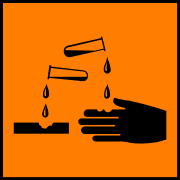|
A buffer solution is a solution that resists change in pH when small amounts of acids or bases are added. |
|
Buffering action
Addition of small amounts of acid to most solutions causes a dramatic change in pH. Addition of one drop (about 0.05cm3) of 0.1 mol dm-3 HCl produces a change in pH of about 3 units in 25cm3 of pure water (pH7).
|
Example: Show the pH change that results from addition of 0.05cm3 of 0.1 mol dm-3 hydrochloric acid to 25cm3 water (pH=7). Total moles of acid = 0.05 x 10-3 x 0.1 = 5 x 10-6 moles Concentration = moles/litres = 5 x 10-6 / 0.02505 = 1.996 x 10-4 mol dm-3 final pH = -log[H+] = 3.69 |
However, some solutions resist changes in pH when small amounts of acid or base are added. On addition of acid, the hydrogen ions get removed by one of the components of the mixture and on addition of base, the hydroxide ions get removed by one of the components of the mixture. The effect is called buffering action. Solutions that behave this way are called buffers.
There are two types of buffer.
- 1 Weak acid and the salt of the same weak acid, (for example a solution containing ethanoic acid and sodium ethanoate). This gives a buffer solution with a pH less than 7
- 2 Weak base and the salt of a the same weak base (for example ammonia and ammonium chloride solution). This gives a buffer with a pH greater than 7
The first (acidic) buffer works in the following way.
If an acid is added it combines its free hydrogen ions with the ions from the salt of the weak acid, making the molecular form of the weak acid, which cannot affect the pH.
If a base is added the OH- ions from the base react with the H+ ions that are present from the weak acid dissociation. Having been removed from the solution this stimulates the weak acid to produce more H+ ions (Le Chatelier's Principle) and the original pH is re-established.
Acidic buffers
Acidic buffers, i.e. buffers with a pH of below 7, are formed from a solution containing a weak acid and one of its salts. The most common example is a mixture of ethanoic acid and sodium ethanoate.
Two equilibria are established:
equilibrium 1: CH3COOH  CH3COO- + H+
CH3COO- + H+ |
The first equilibrium lies 99% to the left hand side (i.e. there is a large store of ethanoic acid molecules)
equilibrium 2: CH3COONa  CH3COO- + Na+
CH3COO- + Na+ |
The second equilibrium lies almost 100% to the right hand side (i.e. there is a large store of ethanoate ions)
Hence, the mixture has large quantities of both ethanoic acid molecules [CH3COOH] from the first equilibrium, and ethanoate ions [CH3COO-] from the second equilibrium.
Addition of small quantities of acid (H+)
The H+ ions added react with the excess ethanoate ions in equation 2 and are removed from the solution as ethanoic acid molecules (these have no effect on the pH).
Hence the pH stays the same.
Addition of small quantities of base (OH-)
In this case, the OH- ions react with the hydrogen ions from the first equilibrium removing them from the right hand side.
There is, however, a large reservoir of ethanoic acid on the left hand side of this equilibrium able to dissociate and make more hydrogen ions, restoring the pH.
Basic buffers
A basic buffer is made from a solution containing a weak base and one of its salts. The most common example is a solution of ammonium chloride (salt of a weak base) and ammonia solution (weak base).
In this case there are two equilibria:
equilibrium 1: NH3 + H2O  NH4+ + OH-
NH4+ + OH- |
This equilibrium lies very much to the left hand side (i.e. there is a large reserve of free ammonia molecules)
equilibrium 2: NH4Cl  NH4+ + Cl-
NH4+ + Cl- |
This equilibrium lies 100% to the right hand side (i.e. there is a large reserve of ammonium ions)
Addition of small quantities of acid (H+)
The H+ ions from the acid react with the OH- ions from equilibrium 1 and remove them.
However, there is a large reserve of ammonia molecules available to dissociate from the left hand side making more OH- ions restoring the pH (remember that the value of [H+][OH-] must be constant under all conditions except a change of temperature)
Addition of small quantities of base (OH-)
Adding more OH- ions that can react with the free ammonium ions (from equilibrium 2) producing more ammonia (as in equilibrium 1) and effectively being removed from the system.
The ammonia molecules have no effect on pH an therefore the pH remains the same.


